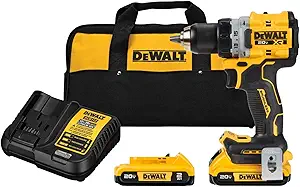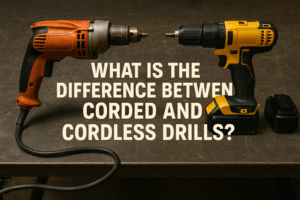What is the Difference Between Corded and Cordless Drills?
In the world of power tools, there are few debates as fundamental as corded versus cordless. It’s the first major decision every tool buyer faces, a crossroads that will define how and where you can work. On one side, you have the raw, unrelenting power of the corded drill, tethered to an outlet. On the other, the go-anywhere freedom of the cordless drill, powered by a battery. But the difference is so much more than just a plug.
This single distinction—the power source—creates a cascade of trade-offs in performance, portability, price, and even ergonomics. The question isn’t simply “which one is better?” The real question is, “which one is better for you and the work you need to do?”
This is your definitive guide. We are going to put these two tool philosophies head-to-head, breaking down every critical difference with expert analysis. By the end, you’ll be able to walk into any hardware store or browse online with the absolute confidence that you’re making the right choice for your projects, your workshop, and your budget.
The Fundamental Difference: AC vs. DC Power
At its core, the entire debate boils down to how the drill gets its electricity.
- Corded Drills run on Alternating Current (AC). They plug directly into a standard 120-volt wall outlet. The power is consistent, powerful, and, for all practical purposes, endless.
- Cordless Drills run on Direct Current (DC) provided by a portable, rechargeable battery pack. These are almost exclusively Lithium-Ion (Li-ion) batteries, which store a finite amount of energy.
From this one difference, all other pros and cons emerge. Let’s break them down across the five key battlegrounds.
Head-to-Head: The 5 Key Battlegrounds
Battleground #1: Power & Performance
This is the most hotly debated topic. While the gap has narrowed significantly in recent years, there are still crucial differences in how these tools deliver power.
Corded Drills: The Unrelenting Brawler
The strength of a corded drill isn’t just its peak power; it’s the sustained, consistent delivery of that power. A 10-amp corded drill delivers 10 amps of muscle from the moment you start until the moment you stop, whether that’s five minutes or five hours from now. It never fades, gets tired, or bogs down. This makes it the undisputed champion for high-demand, continuous tasks:
- Mixing large batches of mortar, grout, or drywall mud.
- Using large-diameter hole saws or self-feed bits in dense wood.
- Drilling through thick steel or plate metal.
- Extended periods of hammer drilling into concrete.
Power for corded drills is measured in Amps (A). More amps means a more powerful motor capable of handling more strain without overheating.
Cordless Drills: The Agile Athlete
Modern cordless drills, especially high-end brushless models, are astonishingly powerful. They can often match or even exceed the peak torque (twisting force) of their corded counterparts. They deliver incredible “burst” power. However, this power is finite. As the battery drains, the power output will gradually decrease. While this is less noticeable with today’s technology than it used to be, it’s still a factor. Pushing a cordless drill with a low battery on a demanding task can strain both the tool and the battery.
Power for cordless drills is primarily measured in Volts (V). A higher voltage platform (like 18V/20V MAX) has a higher power potential than a lower voltage one (like 12V).
The Verdict: For sheer, unstoppable, all-day power for the most demanding jobs, corded drills still hold the crown. For the vast majority of DIY and even professional construction tasks, a high-quality cordless drill is more than powerful enough.
Battleground #2: Portability & Convenience
This is where the tables turn dramatically. It’s the entire reason cordless technology was invented.
Cordless Drills: The Freedom Fighter
This is the cordless drill’s knockout punch. There are no cords to trip over, no searching for the nearest outlet, and no fumbling with tangled extension cords. You can seamlessly move from the workshop to the backyard, from the ground floor to the roof. This unparalleled mobility makes cordless drills faster and more efficient for jobs that require movement, like:
- Working on a ladder or scaffolding.
- Projects in the middle of a yard, far from an outlet.
- Quick repairs anywhere in the house.
- Working in tight, awkward spaces like inside a cabinet.
Corded Drills: The Workshop Warrior
The cord is the corded drill’s greatest weakness. You are permanently tethered to a power source, and your range is limited by the length of your cord and any extension cords you use. The cord can get snagged, become a tripping hazard, and can be cumbersome to manage, especially on a busy job site.
The Verdict: This is a decisive, undisputed victory for cordless drills. In terms of convenience and portability, there is no contest.
Battleground #3: Weight & Ergonomics
How the tool feels in your hand after an hour of use is a critical, often overlooked, factor.
Corded Drills: Lighter Power
Because they don’t need to carry their own power source, corded drills can often be lighter than a cordless drill of the equivalent power class. An 8-amp corded drill might be noticeably lighter than a high-performance cordless hammer drill with a large 5.0 Ah battery attached, which can reduce user fatigue during overhead or extended use.
Cordless Drills: The Battery Burden
The battery is a significant source of weight and affects the tool’s overall balance. A large battery can make the drill feel bottom-heavy. However, the cordless world offers incredible variety. The ultra-compact and lightweight 12V drills are far lighter than any serious corded model, making them ergonomically superior for light-duty tasks.
The Verdict: This is a draw. A high-power cordless drill is generally heavier than its corded rival. A compact cordless drill is significantly lighter. The best choice depends on the specific task.
Battleground #4: Cost of Ownership
The price tag on the box is only the beginning of the story.
Corded Drills: The Budget-Friendly Bet
For the same amount of power, a corded drill almost always has a lower initial purchase price. There are no expensive batteries or chargers to buy. Furthermore, the long-term cost is minimal. With no batteries to wear out and replace, a corded drill you buy today could still be running in 20 years with virtually no additional investment.
Cordless Drills: The Platform Investment
Cordless tools are more expensive upfront because you are not just buying a tool; you are investing in a battery platform. The batteries and chargers are a significant part of the cost. Additionally, batteries are consumables. After several hundred charge cycles (typically 3-5 years of heavy use), they will begin to lose their ability to hold a charge and will eventually need to be replaced, which is a significant long-term cost.
The Verdict: For both initial and long-term cost, corded drills are the clear winner. They provide the most power for your dollar.
Battleground #5: Maintenance & Durability
A tool is only a good value if it lasts.
Corded Drills: Simple and Robust
With a relatively simple design—a motor, switch, gearbox, and cord—there are fewer things that can go wrong. A quality corded drill is a tank. With basic care, like keeping the vents clean, it can withstand decades of hard use. The most common failure point, the carbon brushes in older motor designs, are cheap and easy to replace.
Cordless Drills: Complex and Advanced
Modern cordless tools are packed with sophisticated electronics in the tool, the battery, and the charger. This complexity adds more potential points of failure. The battery is the most common component to fail and is expensive to replace. While well-built cordless tools are very durable, they simply have more components that can break than their simpler corded cousins.
The Verdict: Due to their simpler mechanics and lack of consumable batteries, corded drills generally have a longer potential lifespan and are more durable over the long haul.
| Feature | Corded Drills | Cordless Drills |
|---|---|---|
| Power | 🥇 Sustained & Consistent | 🥈 High Peak/Burst Power |
| Portability | 🥈 Limited by Cord | 🥇 Total Freedom |
| Cost | 🥇 Lower Initial & Long-Term | 🥈 Higher Initial & Battery Replacement |
| Durability | 🥇 Simpler, Longer Lifespan | 🥈 More Complex, Finite Battery Life |
| Best For | Workshop, Heavy-Duty, Stationary Tasks | Job Site, Home Repairs, All-Around Use |
Who Should Buy Which Drill?
Choose a Corded Drill if…
- You work primarily in a workshop or garage near a power outlet.
- Your main tasks involve high-demand, continuous power (mixing, heavy metal drilling).
- You want the absolute most power for the lowest possible price.
- You are a budget-conscious DIYer who values longevity and low maintenance costs.

The Corded Workhorse: DEWALT DWD210G 10-Amp Pistol Grip Drill
This drill is the embodiment of the corded philosophy. Its powerful 10-amp motor is built for high-torque applications and won’t back down. It’s a simple, robust, and incredibly powerful tool that will last for years. It’s the perfect choice for a dedicated workshop bench or for anyone who needs serious, reliable power.
Check Price on AmazonChoose a Cordless Drill if…
- You value speed, mobility, and convenience above all else.
- You work on varied job sites, outdoors, or on ladders.
- You are a homeowner or DIYer tackling a wide range of repair and assembly projects.
- Your budget allows for an investment in a good battery platform.

The Cordless Champion: DEWALT 20V MAX XR Brushless Drill (DCD800D2)
This tool represents the pinnacle of modern cordless technology. Its brushless motor is powerful and efficient, it’s compact and ergonomic, and it’s part of a massive system of compatible tools. For 95% of tasks, this drill provides all the power you’ll ever need, with none of the hassle of a cord. It’s the go-to choice for most users in 2025.
Check Price on AmazonThe Hybrid Approach: Why Pros Own Both
For most professionals and truly serious DIYers, this isn’t an “either/or” choice. They own a full cordless system for their daily tasks—driving screws, drilling holes, and general construction. But they also keep a powerful corded drill, like a heavy-duty hammer drill or a low-RPM mixer, in the truck for those specific, high-demand jobs where nothing else will do. This “best of both worlds” approach is the ultimate solution.
Conclusion: The Choice is Yours
The corded vs. cordless debate is a classic for a reason. It represents the ultimate trade-off between raw, unending POWER and go-anywhere PORTABILITY. There is no universal


